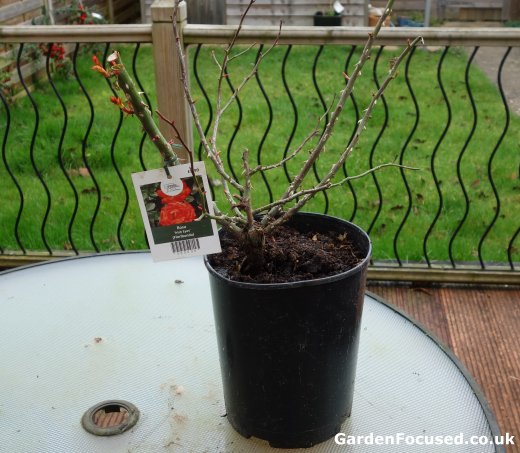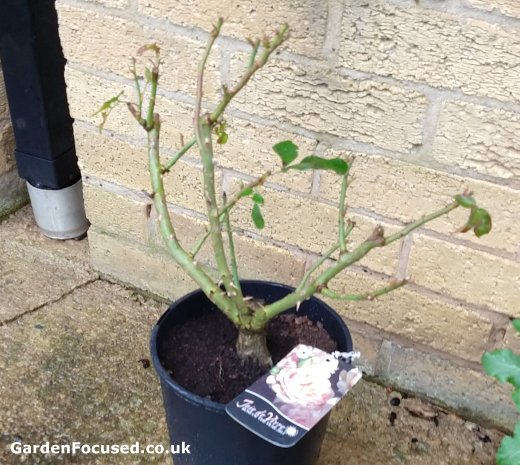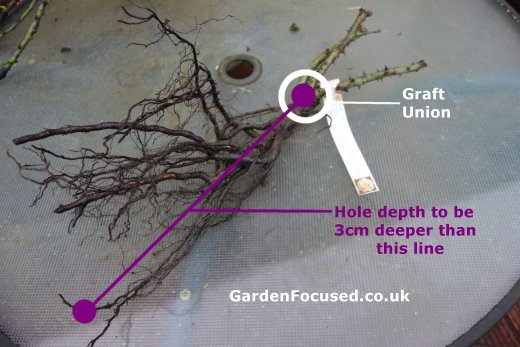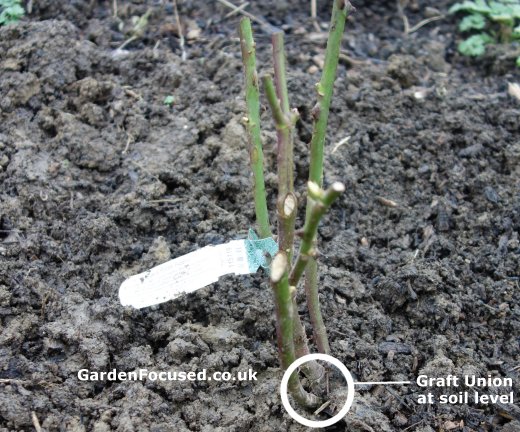BARE ROOT ROSES
These are rose bushes which have been grown in the open for a year and then dug up when they are dormant in the winter or early spring. They are sold with no soil on the roots and for this reason they need to be planted in their final position as soon as you receive them.

![]()
Bare root rose ready for planting
If you can’t plant a bare root rose in its final position within a week of delivery, and let’s face it, roses are delivered at the coldest time of year, then you will need to heel it into a patch of soil which is not frozen. Alternatively you can place the roots in a container and pack with moist compost.
The first advantage of bare root roses is that they are much lighter than containerised or container grown roses and therefore can be sold online at a significantly lower cost as far as postage and packing goes.
Bare root roses tend to establish quicker compared to container grown roses. They are sold when the plants are dormant, normally November to early March.
CONTAINERISED ROSES
These are the same as bare root roses with the exception that when the roses are dug up the roots are placed in a pot full of compost. They are then sold in the pot very soon after.
A containerised rose can easily remain in the container for a month or two as long as it is kept watered. So when your rose arrives there is no mad rush to plant it out. You can wait (within reason) until the conditions are correct for planting out and when you have time.

![]()
A containerised rose ready for planting
The disadvantage of a containerised rose is the weight of the compost and to a lesser degree the container. This make postage costs much higher. The packing costs are also higher because the container, compost and rose need to be securely placed inside a much larger cardboard box.
Containerised roses establish themselves just as quickly as a bare root rose. They are sold when the plants are dormant, normally November to early March.
CONTAINER GROWN ROSES
A container grown rose is one which has been dug up from the growing field when it is dormant (exactly as a bare root or containerised rose) but it is then placed in a container and grown on for six months or more in that container before it is sold.
A container grown rose will need to be watered and fed by the grower all thetime it is kept in the container.
The only advantage of a container grown rose is that it can be sold at any time of the year, even in the summer.
The disadvantages are significant. First, a container grown rose is more expensive compared to the previous two forms of rose.
They also tend not to establish themselves as well as bare root or containerised roses. One reason for this is that the roots have been constricted in a container which is not really large enough for optimum growth conditions.

![]()
A container grown rose – Joie de Vivre
There is a small story attached to why we bought the container grown grown shown above, and it certainly shows the way forward if you want to buy a rose cheaply, in good condition and at the same time plant it at the correct time of year. Click this link to
Joie de Vivre and scroll down to the cultivation record section if you are interested.
In addition, if a rose is planted when it it not dormant (mid spring to late autumn) it will inevitably require more significant and regular watering compared to a bare root or containerised rose. Those roses have had a chance to grow roots during the wetter months making them far less reliant on manual watering.
With all those disadvantages you may wonder why garden centres sell container grown roses. The answer is simple, they want to be able to sell roses at all times of the year. They rarely mention the downside to buying a container grown rose at a rather inappropriate time of the year for the plant’s health.
WHERE TO PLANT ROSES
The very best place to plant a rose is in a full sun position in soil which is moist (not waterlogged) and free-draining. Roses are relatively hungry plants so a soil rich in nutrients is best although don’t over feed with nitrogen.
Clay soils suit roses very well, lighter soils, such as sandy soils are bestimproved by the addition of lots of organic matter. Roses will tolerate partialshade well, heavy shade will be a problem.
One final point worth mentioning is that roses are best planted where this is free air movement. Planting them in very protected positions will encourage fungal diseases.
WHEN TO PLANT ROSES
Bare root roses should be planted as soon as possible, certainly within a week of receiving them. If that’s not possible, place them in a pot of moist compost in a protected position. Bare root roses are on sale (weather permitting) from November to early March.
Containerised roses are normally also only sold from November to early March and should be planted as soon as possible. They will last in the container for a moth or so if watered.
Container grown roses can be planted at any time of the year although they will require frequent watering if planted in warm weather.
HOW TO PLANT ROSES
When you remove a containerised rose from its post, almost all the compost will fall off – don’t be surprised, that’s perfectly normal. At that point the containerised rose can be treated exactly the same as a bare root rose.
Dig out a hole about twice the width of the roots. The depth of the holeshould be such that the graft union (see picture below) is level with surface ofthe soil and the roots are just above the base of the hole.

![]()
Depth to dig hole
Sprinkle a handful of fish, blood and bone fertiliser onto the dug out soil and mix it in with a trowel.
Place the rose in the hole and start infilling the hole with the dug out soil. Aim to get the graft union level with the soil surface – see the picture below.

![]()
Rose planted to correct depth
When planted, firm down the soil surrounding the rose with your boot – don’t use excessive pressure, just enough to ensure that any air gaps in the soil are clsed. Water well. Remember to leave a marker to show which variety has been planted.
A container grown rose is planted in a similar manner and to the same depth. When you tip the plant out of the pot, the soil will remain around the rootball. It’s a good idea to tease the soil away from the bottom 5cm / 2in of the root ball and spread those roots out. This will help the container grown rose to establish well.
If you are planting more than one rose, they are normally planted 60cm / 2ft to 90cm / 3ft apart depending on how large a particular variety will grow.
Most rose growers will have pruned their roses correctly, ready for planting. Some may not though. Read the instructions which come with the rose to work out if further pruning is required.
Typically, hybrid tea roses will be pruned back to about 12cm / 5in to 15cm /6in above ground level. Floribunda roses will be pruned back to about 15cm / 6in to 18cm / 7in above ground level. Climbing and rambling roses will be pruned back to about 40cm / 15in above ground level.
Recommended Rose Varieties for Small / Medium Gardens
Planting a Rose Bush
Caring for Rose Bushes
Prunining Rose Bushes
Propagating Rose Bushes from Hardwood Cuttings
Pests and Diseases of Rose Bushes
Comparison of online rose suppliers
HOW TO PLANT A ROSE BUSH
If a rose bush is well looked after it will live for 25 years or more so it makes good sense to plant it correctly so that it gets off to a good start.
Roses are normally sold in three forms (explained in detail below) and all three forms are planted in basically the same manner with only slight variations.
This article also explains when and where it’s best to plant rose bushes.